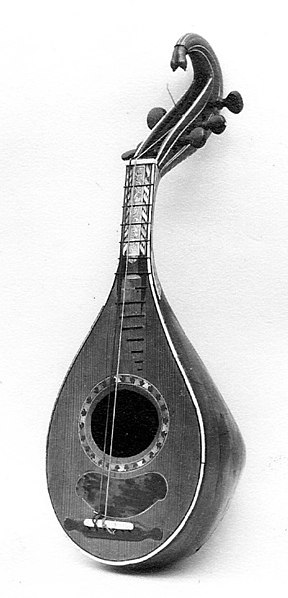The gittern was a relatively small gut-strung, round-backed instrument that first appeared in literature and pictorial representation during the 13th century in Western Europe. It is usually depicted played with a quill plectrum, as can be seen clearly beginning in manuscript illuminations from the thirteenth century. It was also called the guiterna in Spain, guiterne or guiterre in France, the chitarra in Italy and Quintern in Germany. A popular instrument with court musicians, minstrels, and amateurs, the gittern is considered an ancestor of the modern guitar and other instruments like the mandore, bandurria and gallichon.
Five course Gittern or "Quintern" dated 1450, built by luthier Hans Oth
Gittern (right) depicted in a c. 1322 fresco scene from the life of St. Martin of Tours. The instrument on the left is a set of aulos.
Juan Oliver's c.1330 painting at Pamplona Cathedral, showing a musician playing a gittern.
By 1575, the German quintern included guitar-shaped instruments.
The mandore is a musical instrument, a small member of the lute family, teardrop shaped, with four to six courses of gut strings and pitched in the treble range. Considered a French instrument, with much of the surviving music coming from France, it was used across "Northern Europe" including Germany and Scotland. Although it went out of style, the French instrument has been revived for use in classical music. The instrument's most commonly played relatives today are members of the mandolin family and the bandurria.
Mandora c. 1700–1799 exhibited at the Metropolitan Museum of Art, NY
Lombardic mandolin with 12 strings in 6 courses. The bridge is glued to the soundboard, like a guitar's bridge
A "Mandörgen" from the 1619 book Syntagma Musicum II by Michael Praetorius. See Praetorius' Plate 16. The instrument appears to have four courses of strings; three single strings and a set of double strings on the right
An example of a mandore made by Boissart, in the collections of the Victoria and Albert Museum. The back and neck are one piece, carved from a block of pearwood, and features images of Juno, Minerva and Venus in a beauty contest, the Judgement of Paris. The gargoyle-like head at the bottom is Medusa








